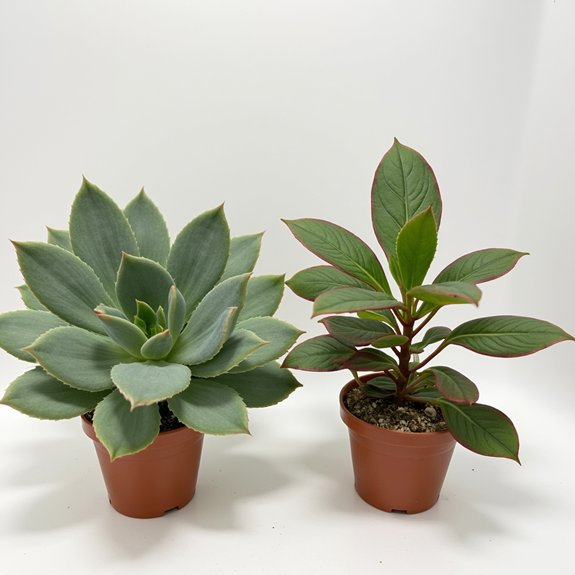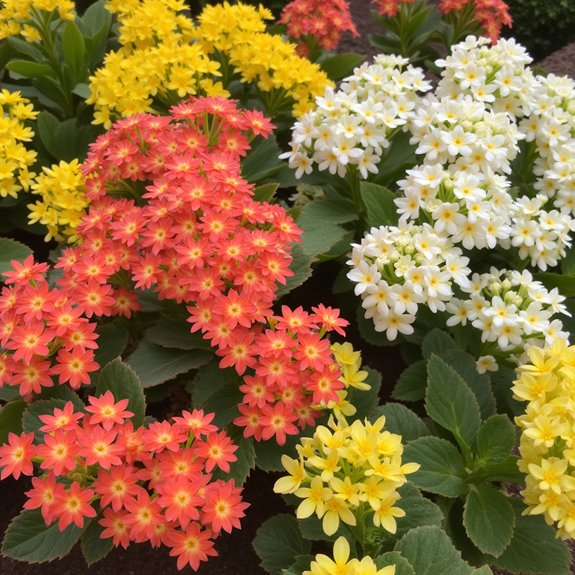Gardeners frequently confuse Kalanchoe delagoensis and Kalanchoe daigremontiana, though these Madagascar natives possess distinct characteristics that separate them completely. Both species earn the nickname “Mother of” plants due to their prolific plantlet production, yet their leaf shapes, flowering patterns, and growth habits couldn’t be more different. Understanding these differences becomes essential when selecting the right specimen for specific garden conditions, especially considering their vastly different space requirements and potential invasive behaviors.
Contents
Origins and Botanical Classification

While both plants share the Kalanchoe name, they’re actually distinct species with fascinating Madagascar origins. Kalanchoe delagoensis (Mother of Millions) and Kalanchoe daigremontiana (Mother of Thousands) both hail from this island nation off Africa’s southeastern coast. These succulents belong to the Crassulaceae family, which includes over 1,400 species worldwide.
Their Kalanchoe history traces back centuries in Madagascar’s arid regions, where they evolved unique reproductive strategies. Both species developed the remarkable ability to produce plantlets along their leaf margins, ensuring survival in harsh conditions. This adaptation made them incredibly resilient travelers when introduced globally.
Physical Characteristics and Identifying Features
Despite their similar names and reproductive habits, these two Kalanchoe species display distinctly different physical features that make identification straightforward. The leaf morphology provides the clearest distinction between them. Mother of Millions develops smooth, narrow, oblong leaves with a distinctive grey-to-silver sheen and red splotches.
Mother of Thousands, however, produces wider blue-green leaves with prominent toothed margins along the edges. These color variations extend to their flowers as well. Mother of Millions blooms in warm yellow, orange, and red tones, while Mother of Thousands displays cooler grey, pink, and purple hues when flowering occurs.
Flowering Patterns and Bloom Colors

When these Kalanchoe species reach maturity, they’ll develop tall flower spikes that showcase their distinct color palettes. Mother of Millions produces vibrant yellow, orange, and red tubular blooms that create a warm, fiery display. In contrast, Mother of Thousands develops cooler-toned flowers in shades of grey, pink, and purple.
Both species typically flower during winter months, though flowering frequency depends on light exposure and plant age. Mature plants produce more consistent blooms annually.
The blooms themselves offer impressive bloom longevity, lasting several weeks when conditions remain favorable, making these succulents rewarding for patient growers.
Growth Habits and Mature Size
Beyond their colorful blooms, these Kalanchoe varieties display remarkably different structural characteristics that become more pronounced as they mature. Mother of Millions develops an upright, columnar growth habit with narrow, oblong leaves creating a sleek appearance. In contrast, Mother of Thousands adopts a bushier profile due to its wider blue-green leaves with toothed margins.
Growth patterns reveal distinct size comparisons between these succulents. Mother of Millions maintains a more compact, vertical structure, while Mother of Thousands spreads outward with broader foliage. Both species showcase medium growth rates, but their contrasting architectures become increasingly evident as they reach maturity.
Care Requirements and Environmental Needs

Although these Kalanchoes display different growth patterns, they share remarkably similar care requirements that make them ideal for both beginners and experienced gardeners. Their sunlight preferences are identical, thriving in 6-8 hours of direct sunlight daily. Both tolerate partial shade but grow more vigorously in full sun conditions.
Watering techniques remain consistent between species. Check soil moisture by inserting your finger 1-2 inches deep, watering only when dry. These drought-tolerant plants prefer infrequent, deep watering over frequent shallow drinks.
Well-draining cactus mix prevents root rot, while containers need adequate drainage holes for optimal health.
Propagation Methods and Invasive Potential
Both Kalanchoe species excel at self-propagation through their signature plantlet production, creating what many gardeners call “living confetti.” The tiny plantlets develop along leaf margins, complete with roots and miniature leaves, ready to establish themselves wherever they land.
This remarkable ability makes both species highly adaptable but also problematic. They’re classified as invasive species in Australia, parts of Africa, and several island nations. Indoor cultivation helps control spread, but outdoor plantings can quickly colonize surrounding areas.
Propagation requires minimal effort—plantlets root within days of touching moist soil, making containment challenging in suitable climates.
Safety Considerations and Toxicity Warnings
While these prolific propagators bring joy to succulent enthusiasts, they harbor a serious hidden danger that demands respect. Both Mother of Millions and Mother of Thousands contain toxic compounds called Bufadienolides, which pose significant livestock risks and threaten human safety.
These poisonous substances can cause cardiac arrest and heart failure in animals that graze on the plants. Pet owners must keep these succulents completely out of reach from curious cats, dogs, and children.
The toxicity remains present in all plant parts, making proper placement and handling absolutely critical for safe cultivation.
